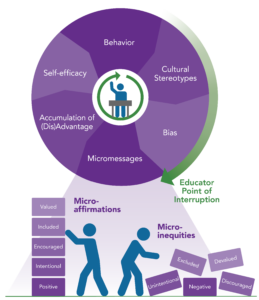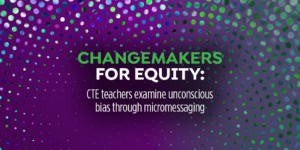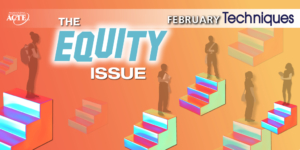Changemakers for equity: CTE teachers examine unconscious bias through micromessaging
Recent years have brought into sharp focus the need for educators to provide every student the best opportunity to succeed. This idea of equity in education is timely but not new. The National Alliance for Partnerships in Equity (NAPE) has long stood at the forefront of efforts to assist educators and stakeholders as they work to support all learners in pursuit of high-quality education and fulfilling careers.
Students from marginalized communities — socioeconomically disadvantaged students, women and girls, members of the LGBTQ+ community, students with disabilities, and students of color — often face limited access to resources and differential treatment in classrooms, leading to opportunity gaps. Unfortunately, in career and technical education (CTE), marginalized students are even more likely than their counterparts to have these experiences.
Lessons learned from NAPE’s Educators Equity in STEM II Academy (EE-STEM II) can help educators interrupt the inequities that students face using evidence- based, multimodal programming.
The Micromessaging Academy
In September 2016, NAPE received an award from the National Science Foundation (NSF) Advanced Technological Education (ATE) program to conduct the EE-STEM II project, also known as the Micromessaging Academy. NAPE established EE-STEM II (supported by the National Science Foundation under Grant No. DUE-1601548) to enhance the teaching skills of STEM and CTE educators. In particular, the goal was to increase academic outcomes for marginalized students.
The Academy included four components:
- A four-day summer institute — delivered in two cohorts (46 participants each)
- Eight NAPE-facilitated, monthly professional learning community (PLC) meetings hosted during the academic year
- Participant tools and resources that enhanced work begun at the summer institute
- A virtual capstone presentation, during which participants discussed their work and its impact on student outcomes
Micromessages act as conduits and barriers to equity.
The EE-STEM II Academy began with the premise that educators can build their capacity to encourage students toward academic success using micromessages. Micromessages are positive and negative — verbal, nonverbal, paraverbal and environmental — cues that are sent to students by individual educators and institutions.
Positive micromessages, known as microaffirmations, affirm student value, communicate belonging and convey support. Generally, microaffirmations are intentionally given. Negative micromessages, known as microaggressions, convey stereotypes and/or may represent differential treatment levied against marginalized persons individually, or marginalized groups institutionally. They are most often unintentional. While the use of microaggressions is associated with diminished self-efficacy in students, microaffirmations increase self-efficacy, enhance feelings of belonging, and encourage growth mindset.
Guided by the framework of the NAPE Culture Wheel, Micromessaging Academy participants became immersed in the study of micromessages. Through group work and interactive exercises, participants identified their own use of micromessages. And they discussed how they can interrupt these messages to encourage self-efficacy.

Outcomes
Results were overwhelmingly positive. Most participants (93%) said that they had shifted their educational practices in some way. They reported improved understanding and skill related to micromessaging after attending the Academy. Most often, participants said that they began to identify and challenge cultural stereotypes in their lives, on their campuses or institutions, and among their interactions with others. Further, they reinforced a growth mindset by using microaffirmative techniques, praising students for their efforts instead of perceived intelligence.
Participants also reported a greater institutional awareness of the need to create equitable learning environments for students. And they discussed equity and student performance more frequently. For some, the experience proved valuable in ways that they did not expect. An attendee from the New Mexico cohort shared their experience. “I was inspired by the change I could make in the classroom with regards to the lifetime of success I could impress on my students. I was inspired by finally understanding how to categorize the issues my students and I face as inequities and not inequalities. The EE-STEM II Academy helped me engage with students and colleagues who want to interrupt the circle of inequity.”
Examine micromessaging to improve equity.
The EE-STEM II Project, utilizing NAPE’s Micromessaging to Reach and Teach Every Student curriculum, has helped educators increase their understanding of how microaggressions can create barriers to students’ access and success in STEM and CTE pathways. They also learned how to take action to interrupt and remove those barriers.
You, too, can build awareness and practice positive micromessaging within your educational communities. We know that COVID-19 and its impact on the education systems affected students from marginalized communities in a disproportionate way. The skills and knowledge provided to educators as part of the Micromessaging Academy can assist in mitigating the effect of this ongoing threat to students’ educational success.
Strategies related to people & environment
- Introduce students to role models and mentors, personally and in the curriculum, who share similar individual, cultural and intersectional identities.
- Become aware of your own unconscious biases by conducting peer observations. Invest in education around intersectional equity and identity. Ask your students for feedback, and videotape your class for self-reflection.
- Shift group work from task-based assignments to creative problem-solving activities that honor diverse experiences, perspectives, and ways of learning to build belonging and self-awareness.
Strategies related to program materials
- Use photos or images strategically to counter stereotypes and diversify representation so thatstudents receive messages that they belong.
- Teach students to think critically about the ways in which the media portray STEM and CTEprograms and careers.
- Assess the cultural attitudes, values, strengths and challenges of your students. Then integratetheir diverse perspectives into CTE/STEM curricula and programs to build inclusion and equity.
Strategies related to policies and practices
- Initiate culturally relevant CTE and STEM recruitment campaigns that involve family membersand build social and cultural capital for all participants.
- Give wise feedback. This concept involves teachers setting high standards for students’ success. Express a sincere belief that students can meet their goals, and provide all the necessary support.
These categories influence and build upon each other. Because of this, each context should be considered as a point of intervention — individually and as a unit — to promote equity within STEM and CTE settings. Any educator can use these strategies. You can become an agent of change in the lives of your students and in the movement for educational equity.
Martina L. Sharp-Grier is an assistant professor of sociology at Stark State College and a certified equity instructor for NAPE. She is a doctoral candidate in sociology at The University of Akron. And she is proud to be an honorably discharged veteran of the United States Army Reserve. Sharp-Grier has written and published literature on bullying and microaggressions in the workplace, racial and ethnic relations, and the effects of disparate treatment of minoritized students in education.





